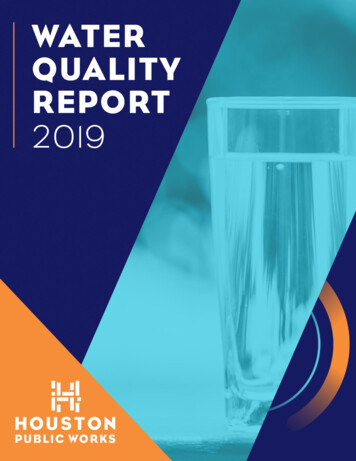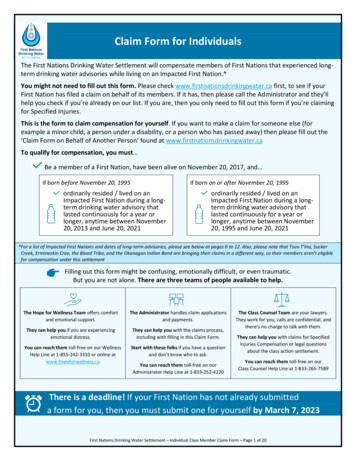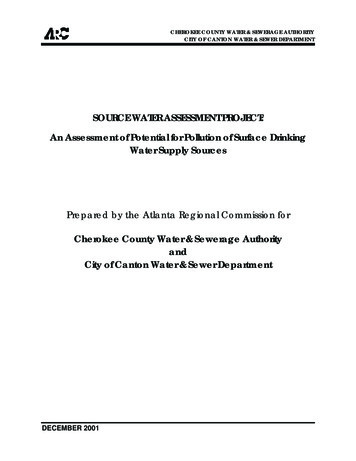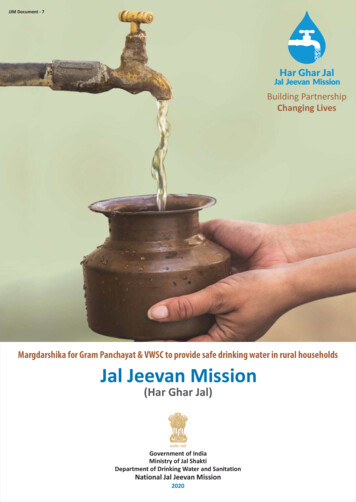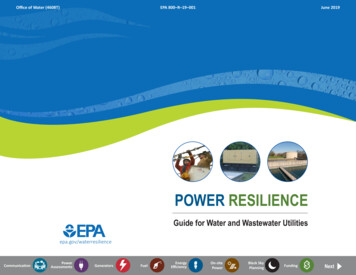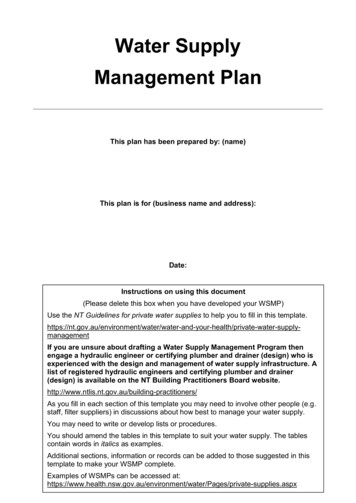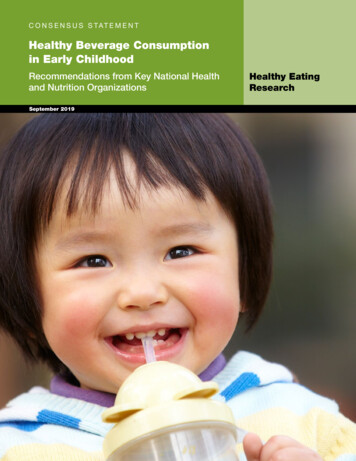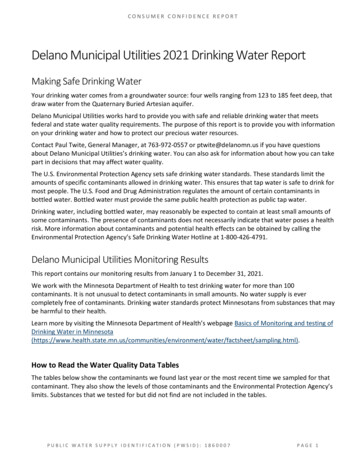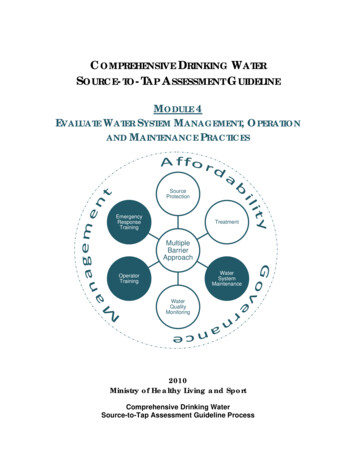
Transcription
COMPREHENSIVE DRINKING WATERSOURCE-TO-TAP ASSESSMENT GUIDELINEMODULE 4EVALUATE WATER SYSTEM MANAGEMENT, OPERATIONAND MAINTENANCE stry of Healthy Living and SportComprehensive Drinking WaterSource-to-Tap Assessment Guideline Process
COMPREHENSIVE DRINKING WATER SOURCE-TO-TAP ASSESSMENT GUIDELINEHere are the steps in the source-to-tap assessment process, through the Introduction and eightmodules. Note that the Introduction should be read prior to undertaking any assessment.MODULE 4: EVALUATE WATER SYSTEM MANAGEMENT, OPERATION ANDMAINTENANCE PRACTICES 2
COMPREHENSIVE DRINKING WATER SOURCE-TO-TAP ASSESSMENT GUIDELINETABLE OF CONTENTS1.INTRODUCTION. 41.1 HAZARD AND VULNERABILITY IDENTIFICATION . 41.2 MODULE 4 ASSESSMENT TEAM . 42.ASSESSMENT COMPONENTS . 52.1 EVALUATE WATER SUPPLY SYSTEM MANAGEMENT STANDARDSAND PRACTICES. 52.2 EVALUATE WATER SUPPLY SYSTEM OPERATION ANDMAINTENANCE PROCEDURES AND PRACTICES . 72.2.1 COMPARE CURRENT PRACTICES WITH THE REQUIREMENTSSET OUT IN THE OPERATING PERMIT . 72.2.2 REVIEW THE ADEQUACY OF OPERATION ANDMAINTENANCE STANDARDS, PROCEDURES AND PRACTICES . 72.2.3 EVALUATE THE BACKFLOW PREVENTION/CROSS‐CONNECTION CONTROL PROGRAM . 92.3 EVALUATE DOCUMENTATION AND REPORTING PRACTICES . 102.4 EVALUATE EMERGENCY RESPONSE AND CONTINGENCYPLANNING PRACTICES. . 113.ASSESSMENT DOCUMENTATION AND REPORTING . 123.1 ASSESSMENT REPORT . 123.2 HAZARD IDENTIFICATION TABLE . 12APPENDIX 4A: MODULE 4 ASSESSMENT AT A GLANCE . 13APPENDIX 4B: RECOMMENDED RESOURCES . 15LIST OF TABLES4‐1. SAMPLE MODULE 4 HAZARD IDENTIFICATION TABLE . 12LIST OF BOXES4‐1. EXAMPLES OF WATER SUPPLY SYSTEM RECORDS . 9MODULE 4: EVALUATE WATER SYSTEM MANAGEMENT, OPERATION ANDMAINTENANCE PRACTICES 3
COMPREHENSIVE DRINKING WATER SOURCE-TO-TAP ASSESSMENT GUIDELINE1.INTRODUCTIONIn this module, the assessment focuses on how the water system functions to provide safedrinking water from a management, operations and maintenance perspective. Module 3considers the physical aspects of the water supply system and Module 4 provides asystematic approach for investigating the human aspect of how the water system is run toadequately safeguard drinking water quality.Issues addressed include water supply system management; operation and maintenancepractices; operator training; backflow prevention and cross‐connection control;documentation and reporting; and emergency response planning. Evaluation proceduresused in this portion of the assessment include interviews with management, operationsand maintenance staff; review of relevant documentation; and onsite inspection.1.1. Hazard and Vulnerability IdentificationThroughout the process of evaluating water supply elements in the source‐to‐tap system,assessors identify and describe hazards that pose a threat to drinking water safety orsustainability, and vulnerabilities in the multiple barrier (multibarrier) system or otherprotective systems (e.g., security).Hazards are recorded in the Hazard Identification Table (see Table 4‐1), which is used todocument hazards in a consistent way throughout the source‐to‐tap assessment process.Information on strengths and vulnerabilities in the drinking water supply system that havebeen identified throughout the assessment is recorded, compiled from each module, andused to inform the multiple barrier system evaluation in Module 7.1.2. Module 4 Assessment TeamA broad range of issues can exist in a water supply system from source to tap. As a result,comprehensive drinking water assessments require a multidisciplinary assessment teamrather than a single assessor. Each module of the Comprehensive Drinking Water Source‐to‐Tap Assessment Guideline requires some specialized skills and a unique spectrum ofknowledge about water sources and systems. Efficiencies may be gained by including theindividuals involved in the screening tool in the Module 4 assessment team, although thismay not be desirable if they need to be interviewed as a part of the assessment.Collectively, the assessment team for Module 4 should have knowledge and experiencerelated to: Assessing the effectiveness of drinking water management practice. Operation of drinking water collection, treatment, storage, and distribution systems. Mechanical and electrical works. Operator training and certification requirements. Identifying cross‐connections in the distribution system and cross‐connection controlprograms.MODULE 4: EVALUATE WATER SYSTEM MANAGEMENT, OPERATION ANDMAINTENANCE PRACTICES 4
COMPREHENSIVE DRINKING WATER SOURCE-TO-TAP ASSESSMENT GUIDELINE 2.Drinking water chemistry.Microbiology and microbes commonly found in drinking water.Public health issues related to drinking water.Legislation relating to drinking water, surface water and groundwater.Risk assessment and risk management.ASSESSMENT COMPONENTS2.1. Evaluate Water Supply System Management Standards andPracticesManagement refers to the decision‐making structure and processes used in a water supplysystem for setting standards and policies; complying with regulatory requirements; staffingand training; and financial planning and administration. Management is a major factoraffecting a water supply system’s performance. It influences all aspects of the system. Theobjective of this portion of the assessment is to determine the extent to which managementpractices contribute to the successful delivery of safe drinking water.As an initial step, evaluate the management practices and standards for the water systemthrough interviews with key staff, and a review of available policies and proceduremanuals. It is important to interview all key players in the management of the water utility,including the water supplier or utility operator. Suggested interview questions to evaluatemanagement practices include (but are not limited to):Structure and Processes Is there a clear plan of organization and control among people responsible for themanagement and operation of the system?Are the functions of operations and management divisions clearly assigned?Lines of communication between operators and water system decision makers need tobe clear and well used for effective water system functioning, and for budgetingpurposes. This is to provide a realistic estimate of operating costs, an accurateinventory of assets, and anticipated capital costs, as well as to allocate fundsappropriately (CCME, 2004). Is there a reporting relationship between the wateroperator and management? Is communication between field operators, supervisors andbudget controllers effective?Standards and Policies Where applicable, are best practices embedded in management practices (e.g., assetrenewal and replacement, cross‐connection control, distribution system monitoring)?Are there clear rules and standards for:oSystem modifications.oNew hook‐ups.MODULE 4: EVALUATE WATER SYSTEM MANAGEMENT, OPERATION ANDMAINTENANCE PRACTICES 5
COMPREHENSIVE DRINKING WATER SOURCE-TO-TAP ASSESSMENT GUIDELINEMain extensions.oCustomer service.Is the water supply system assessed regularly? What type of assessment process isapplied?Are water system personnel aware of the security risks associated with water systemworks? Is management proactive and supportive of security‐enhancing expenditures?Are policies in place that address customer rights and responsibilities?o Compliance with Regulatory Requirements Does the water supplier have a system in place to stay abreast of the latest regulatoryrequirements? Is the water supplier aware of other complementary legislation that maybe in place to regulate their water systems — for example, municipal bylaws on cross‐connection control, and building and land development.Are all water licences and operating permits current?How effective is the relationship between the water supplier and local health authority?Staffing and TrainingUnder Section 9 of the Drinking Water Protection Act, all drinking water system operatorsare required to be certified to the appropriate level, based on the water systemclassification by the Environmental Operators Certification Program (EOCP). Operatorcertification levels are based on the water system class. More information on EOCP can befound at: http://www.eocp.org/docs/guide.pdf. Does the water supplier have a staffing plan to compensate for planned and unplannedoperator absences and staff changes? Are operators certified to an appropriate level, based on the water supply systemclassification? Is the level of training appropriate for each operator’s actual role in the water supplysystem? What is the plan to have operators certified who are not meeting requirements? Are management and operators committed to ongoing training, continuing educationand learning to determine if the system is keeping up with new and changingtechnologies and regulatory requirements? Training options include courses,workshops, seminars and conferences.Financial Planning and Administration Does the water supply have a renewal and replacement plan in place?Does the water supply have a funding plan for training and certification?Does the water supply have funding plan for operating costs?Identify key best management practices that contribute to a safe and sustainable watersupply, and weaknesses that counteract that goal. This should be based on an analysis ofthe water system management structure and processes; standards and policies; complianceMODULE 4: EVALUATE WATER SYSTEM MANAGEMENT, OPERATION ANDMAINTENANCE PRACTICES 6
COMPREHENSIVE DRINKING WATER SOURCE-TO-TAP ASSESSMENT GUIDELINEwith regulatory requirements; staffing and training; and financial planning andadministration.2.2. Evaluate Water Supply System Operation and MaintenanceProcedures and PracticesOperation and maintenance encompass the procedures and practices applied in runningthe water supply system. These include inspection, monitoring, testing, calibrating,maintaining and repairing water supply elements — such as backup components andbackflow prevention, and cross‐connection control features.This portion of the assessment is a structured method for evaluating the operation andmaintenance of the water supply system by: Comparing current practices with the requirements set out in the operating permit. Reviewing the adequacy of operating standards and procedures; testing, inspection, andmaintenance schedules; and system monitoring processes. Evaluating the backflow prevention and cross‐connection control program.2.2.1. Compare Current Practices with the Requirements Set Out in the OperatingPermitOperation and maintenance practices should first be evaluated against the operatingpermit, which authorizes a water system to operate. The permit also specifies performancestandards for the treatment system, operator requirements, and monitoring and reportingprotocols. Evaluate whether the water supplier is meeting the requirements set out in theoperating permit. If no permit exists for the water supply system, identify this as an issue inthe assessment report. Also, evaluate the system against the requirements of the DrinkingWater Protection Act, Drinking Water Protection Regulation and Water Act.2.2.2. Review the Adequacy of Operation and Maintenance Standards,Procedures and PracticesWater supply system operation and maintenance standards, procedures and actualpractices have a tremendous influence on the quality of water between the intake and thetap. Evaluate operation and maintenance practices considering the following criteria(including any others relevant to the water supply system being assessed): Frequency and seasonal timing. Adequacy of processes for the unique needs of the water supply system. Planning. Communications within the organization and with customers.Information on operation and maintenance can be obtained by interviewing wateroperators and reviewing relevant documentation. Some suggested interview questions are:MODULE 4: EVALUATE WATER SYSTEM MANAGEMENT, OPERATION ANDMAINTENANCE PRACTICES 7
COMPREHENSIVE DRINKING WATER SOURCE-TO-TAP ASSESSMENT GUIDELINEOperating Standards and Procedures What are the regular operations/maintenance activities for the water system?Are operation and maintenance manuals, standard operating procedures, and standardmaintenance procedures available to operators for the water supply system?Are positive water pressures maintained at all times?Are treatment chemicals stored and handled safely?Are sanitary wastes and filter backwash disposed of according to Material Safety DataSheets?Is a tamper policy in place (who can work on and access the water system) to ensurethat standards are met and to reduce the risk of cross‐contamination?Testing, Inspection and Maintenance Schedules Is a there a system in place for scheduling routine preventative maintenance, including(but not limited to):oDistribution system flushing/swabbing/pigging?oReservoir management: aeration, artificial circulation, precipitation, sedimentcontrol, flushing and recycling?oSanitation/maintenance of equipment/structures?oStructural repair/replacement/inspection?oTesting and maintaining: fire hydrants, pumps, meters, pressure regulating valves,shutoff valves, altitude valves, blowoffs and other components?Do water system maps show valve locations accurately?Are regular inspections performed?How is the need for repairs identified? How are the repairs subsequently carried out?Is equipment calibrated according to manufacturers” instructions?Is there an adequate supply of essential spare parts and backup componentsAre backup equipment and controls tested? How often and under what conditions?Is backup power tested and operated regularly, both with and without load?Leaks in water distribution pipes can impair water quality due to cross‐contaminationand result in increase costs due to loss of water and property damage. A leak detectionprogram can minimize risks to public health and property, and reduce costs if leaks aredetected early. Is a leak detection program in place?Of the water supplied, what proportion is lost?System Monitoring Processes Are water supply system processes and components monitored adequately?Are source water levels regularly monitored?Is pressure testing undertaken in the distribution system?Are automated supervisory control and data acquisition (SCADA) systems installed,operated, calibrated and maintained according to the manufacturers’ instructions?MODULE 4: EVALUATE WATER SYSTEM MANAGEMENT, OPERATION ANDMAINTENANCE PRACTICES 8
COMPREHENSIVE DRINKING WATER SOURCE-TO-TAP ASSESSMENT GUIDELINE Are trained operators available to respond to SCADA alarms, perform regular checksand calibrations on sensing equipment, and restore proper function to the system in theevent of a power failure?2.2.3. Evaluate the Backflow Prevention/Cross-Connection Control ProgramCross‐connections within a water distribution system are a key public health hazard thatcould result in backflow where nonpotable water or contaminants flow back into thepotable water conveyance system. Backflow results either from a pressure reduction in thewater distribution pipes (back‐siphonage) or from excess pressure in a consumer’s pipesthat forces water to flow against its intended direction (backpressure)(CCME, 2004).Backflow prevention devices can be installed to stop the flow of water from a connectionback into the distribution system.To minimize the risk they pose, cross‐connections and their controls require managementand maintenance. Additionally, water system staff and consumers need to be educatedabout cross‐connections.In the assessment, identify whether a cross‐connection control bylaw is in place orplanned. Does the water supply system have an adequate cross‐connection controlprogram in place, considering its size and type of possible cross‐connections? Acomprehensive inventory of backflow prevention devices in the distribution system is thefoundation of a successful cross‐connection control program. Verify the locations andstatus of backflow preventers in the system.Some water systems have policies requiring backflow prevention devices only onconnections of highest risk, such as industrial operations, whereas others require allconnections to have these devices. Backflow prevention devices should be appropriate tothe particular hydraulic conditions and degree of risk (CCME, 2004).As a part of the program, backflow prevention devices should be inspected, tested andmaintained on a regular basis by a trained person. Are checks and balances in place toensure the program is effective?Consumer education is another critical aspect of reducing risk from cross‐connections.Industrial customers need to be informed about backflow and its causes, and theimportance of installing backflow prevention devices. Even individual households cancreate cross‐connections from hoses attached to taps and left in swimming pools, laundrysinks or other nonpotable sources of water, or through direct connections to other watersources such as a well on the property.Most people are not aware of the risks to drinking water that these situations pose. Watersuppliers should be educating their customers. Determine if a cross‐connection educationprogram is in place for the water system, either through bill inserts, media campaigns orother methods. Throughout the evaluation process, identify where there are shortfalls inthe backflow prevention and cross‐connection control program.MODULE 4: EVALUATE WATER SYSTEM MANAGEMENT, OPERATION ANDMAINTENANCE PRACTICES 9
COMPREHENSIVE DRINKING WATER SOURCE-TO-TAP ASSESSMENT GUIDELINE2.3. Evaluate Documentation and Reporting PracticesDocumentation and reporting are critical aspects of the proper management and operationof a water system. Water system documentation includes records of activities; operationalprocedures; process control; preventative strategies; monitoring; maintenance; andcorrective actions (see Box 4‐1). An established documentation and reporting system isimportant for (NHMRC/ARMCANZ, 2001): Demonstrating that a systematic approach to drinking water quality management isemployed. Facilitating review and audits by providing written evidence of the system. Enabling development and protection of the organization’s knowledge base. Enhancing communication within the organization and with stakeholders. Serving as a mechanism for accountability. Establishing due diligence and credibility. Ensuring documentation is visible andaccessible.Box 4-1. Examples of Water SupplyEach water supply system will have a uniquesuite of useful documents. Box 4‐1 provides alisting of some of the more common types ofwater system records. Using its professionalexperience and judgment, the assessment teamshould identify what the documentationrequirements are for the water supply system forregulatory compliance, management, operation,maintenance and consumer reporting. Once theset of necessary documents are identified, answerthe following questions: Does the water supplier maintain therequired documentation? How are records used? How and where are records stored?, Are backup copies of records stored offsiteand in a safe place? How up to date are the records? Are records reviewed and reported onperiodically?On the flip side of documentation is reporting.The following questions can be used to evaluatereporting processes: Is the water supply system meetingcompliance reporting requirements?System Records (Adapted fromCCME, 2004)y Operating permity Water licencey Driller’s well logy Water quality analysis resultsy Records of flow meter readings andreservoir levelsy Records of continuous monitorsy Flow meter, pump recordsy Laboratory analysis reportsy Operation, maintenance andrepair logsy Inventory recordsy Source/systems assessmentsy Source protection plansy Engineering reports, inspections,drawings, approvalsy Water system mapsy Records of water treatmentchemicals used (type and quantity)y Inventory of MSDS sheetsy Standard operating proceduresy Operation and maintenancemanualsy Customer complaintsMODULE 4: EVALUATE WATER SYSTEM MANAGEMENT, OPERATION ANDMAINTENANCE PRACTICES 10
COMPREHENSIVE DRINKING WATER SOURCE-TO-TAP ASSESSMENT GUIDELINE Does the water supply system publicly report the results of water qualitymeasurements and other important water system information?2.4. Evaluate Emergency Response and Contingency PlanningPracticesEmergency response plans are required under Section 13 of the Drinking Water ProtectionRegulation. Emergency response plans are important to prevent worsening of problems,protect consumers from harm, and reduce costs by preventing complications (CCME,2004). The primary objectives in the assessment of an emergency response plan are todetermine if it is adequate in scope and depth, reasonable to implement, up to date, easilyaccessible, and familiar and understandable to staff in an emergency.An emergency response plan should address all possible situations that could pose a risk todrinking water, and outline specific directives for action when an incident occurs. Foremergency response plans to be effective, they need to be current, so any changes in thewater system require corresponding changes in the plan. Likewise, it is critical that contactnames and numbers for water system management and staff, health authorities, servicecompanies, and media for consumer notification are accurate and up to date in thenotification list. Protocols and templates for public notice should be included for incidentsin which an immediate reporting standard is not met.The emergency response plan should also contain detailed procedures that the respondercan follow to accomplish tasks. Assess whether the emergency response plan containsclear, specific step‐by‐step procedures that can be effectively used by water operators tosafeguard drinking water in potentially high‐stress, emergency situations. Current andcomprehensive content of an emergency response plan is essential to its effectiveness. Theplan must also be accessible to the water system personnel who respond to incidents.Multiple locations should be established for copies of the emergency response plan, so thataction can be taken immediately once an incident is apparent.Coupled with emergency response planning is contingency planning, in which alternativeoptions are available when key aspects of a water system are not functioning. Contingencyplanning includes keeping backup equipment (such as a chlorinator or pump) or parts onhand in the event of a breakdown; establishing an alternative water source in the event ofcatastrophic contamination or water shortages; and providing an alternative electricitysource (such as a generator) in the event of a power failure.Identify whether or not the emergency response/contingency plans are adequate andthorough in scope, reasonable, current, accessible and understandable so they can beeffective tools when potentially hazardous situations occur.The Drinking Water Protection Regulation requires that water suppliers make available asummary of emergency response plans to their customers to increase consumer confidencewhile ensuring that sensitive information is not released. Note in the assessment report ifemergency response plan summaries are available to water customers.MODULE 4: EVALUATE WATER SYSTEM MANAGEMENT, OPERATION ANDMAINTENANCE PRACTICES 11
COMPREHENSIVE DRINKING WATER SOURCE-TO-TAP ASSESSMENT GUIDELINE3.ASSESSMENT DOCUMENTATION AND REPORTING3.1. Assessment ReportThe assessment report should include the following as a minimum for Module 4: List of key best practices in the management, operation and maintenance of the watersupply system, and identification of important weaknesses. Description of documentation and record‐keeping procedures. Reporting requirements and practices (including list of records maintained). Discussion of whether emergency response and contingency plans are adequate,thorough in scope, reasonable, current, accessible and understandable. Supporting documentation. Completed hazard identification table for Module 4 (see Table 4‐1 for an example).3.2. Hazard Identification TableDrinking water hazards identified in Module 4 should be entered into the hazardidentification table. See Table 4‐1 for an example.Table 4-1. Sample Module 4 Hazard Identification TablePossible er(s)HazardNo.DrinkingWaterHazard4-1No crossconnectioncontrolprogramCross-connections can allownonpotable water into thedistribution system.None n notupdatedfor fiveyearsEmergency response plansfunction as the last barrier inemergency or abnormaloperating situations. Contactphone numbers andinformation must be currentfor the plan to be effective.None identifiedEmergencyresponse planning4-3No formalsystem ofhandling orrecordingcustomercomplaintsCustomer satisfaction is a keyindicator of finished waterquality and can provide awarning sign for problems.None identifiedManagementMODULE 4: EVALUATE WATER SYSTEM MANAGEMENT, OPERATION ANDMAINTENANCE PRACTICES 12
COMPREHENSIVE DRINKING WATER SOURCE-TO-TAP ASSESSMENT GUIDELINEAPPENDIX 4A:MODULE 4 ASSESSMENT AT A GLANCEComponents1. ctices.2. oceduresandpractices.RecommendedMethods Evaluate themanagement practicesand standards for thewater system throughinterviews with key staffand a review ofavailable policies andprocedure manuals. Compare currentpractices with therequirements set out inthe operating permit. Review adequacy of:o Operating standardsand procedureso Monitoring processeso Testing, inspection, andmaintenance schedule Evaluate the backflowprevention and crossconnection controlprogram.Scope Structure and processesStandards andpoliciesCompliance withregulatoryrequirementsStaffing and trainingFinancial planningand administration Criteria for evaluatingoperations andmaintenanceprocesses:o Frequency andseasonal timingo Adequacy ofprocesses for theunique needs of thewater supply systemo Planningo Communicationswithin theorganization andwith customersMODULE 4: EVALUATE WATER SYSTEM MANAGEMENT, OPERATION ANDMAINTENANCE PRACTICESDocumentation andReporting Discuss key bestmanagementpractices andimportantweaknesses. Identify as a hazard inthe Hazard ID tableany practice, process,situation (or absenceof one) that could putthe safety of water atrisk. Discuss key bestoperation andmaintenancepractices andimportantweaknesses. Identify as a hazard inthe Hazard ID tableany practice, process,situation (or absenceof one) that could putthe safety of water atrisk. 13
COMPREHENSIVE DRINKING WATER SOURCE-TO-TAP ASSESSMENT GUIDELINEComponents3. Evaluateemergencyresponseandcontingency planningpractices.RecommendedMethods Review water systememergency responseand contingency plansto determine if they are:o Comprehensive.o Up to date.o Reasonable.o Accessible.o Clear/understandable.o Familiar to staff.Scope Any possible situationor scenario that couldput the safety of waterat riskMODULE 4: EVALUATE WATER SYSTEM MANAGEMENT, OPERATION ANDMAINTENANCE PRACTICESDocumentation andReporting Discuss whether ornot emergencyresponse andcontingency plansare adequate,thorough in scope,reasonable, current,accessible andunderstandable. Identify deficienciesin emergencyresponse andcontingency plansthat could put thesafety of water at riskas a hazard in thehazard ID table. 14
COMPREHENSIVE DRINKING WATER SOURCE-TO-TAP ASSESSMENT GUIDELINEAPPENDIX 4B:RECOMMENDED RESOURCESAssessmentCanadian Council of Ministers of the Environment (CCME). 2004. From source to tap:Guidance on the multi barrier approach to safe drinking water. Produced jointly by theFederal‐Provincial‐Territorial Committee on Drinking Water and the CCME WaterQuality Task Group. http://www.ccme.ca/sourcetotap/mba.html.**Lists many other helpful resources, guidance, best practices etc.National Guide to Sustainable Municipal Infrastructure (InfraGuide). 2003. Deteriorationand Inspection of Water Distribution System.http://gmf.fcm.ca/files/Infraguide/Potable Water/Deterior Inspect water distrib syst.pdfUS Environmental Protection Agency. 1999. Guidance Manual for Conducting SanitarySurveys of Public Water Systems; Surface Water and Ground Water Under the DirectInfluence (GWUDI). urv.pdf.Cross-ConnectionsBritish Columbia Water and Waste Association (BCWWA). 2004. Best ManagementPractices: Cross connection control. http://www.bcwwa.org/BMP/index.phpUS Environmental Protection Agency. 2003. Cross Connection Control Manual.http://www.epa.
Here are the steps in the source-to-tap assessment process, through the Introduction and eight modules. Note that the Introduction should be read prior to undertaking any assessment. COMPREHENSIVE DRINKING WATER SOURCE-TO-TAP ASSESSMENT GUIDELINE MODULE 4: EVALUATE WATER SYSTEM MANAGEMENT, OPERATION AND
